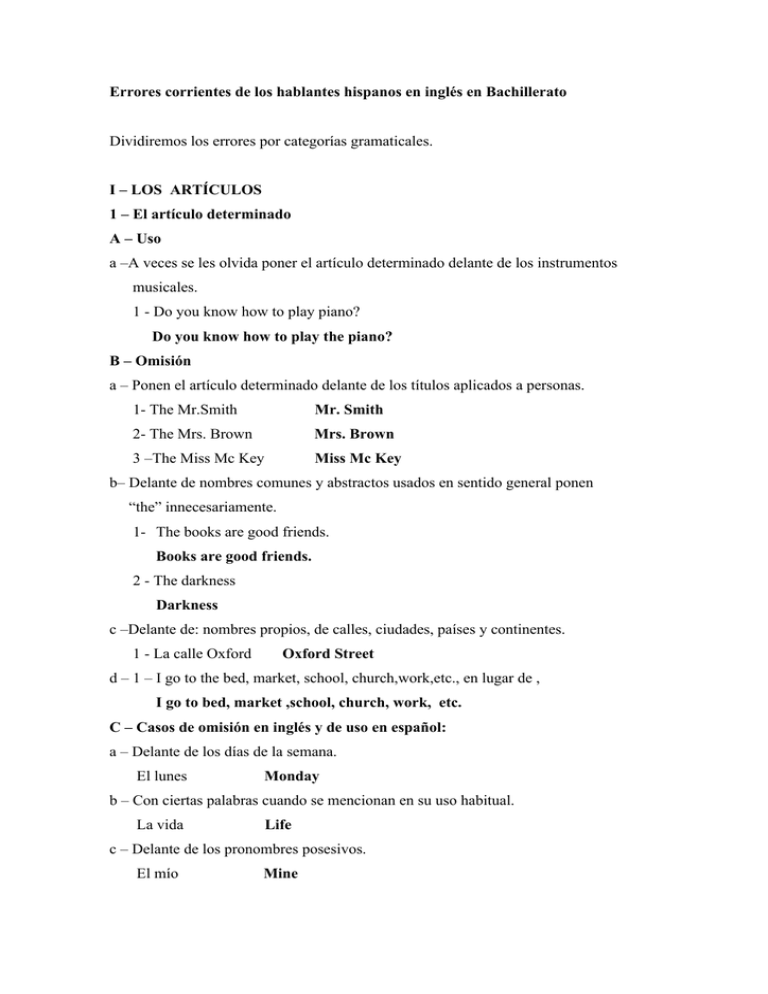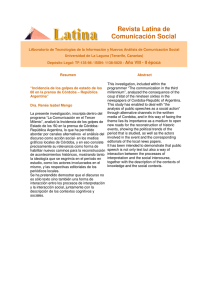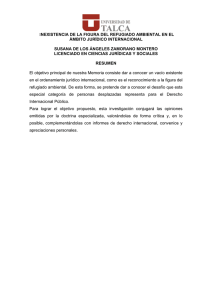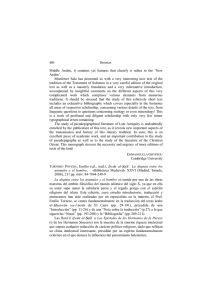Errores corrientes de los hablantes hispanos en
Anuncio

Errores corrientes de los hablantes hispanos en inglés en Bachillerato Dividiremos los errores por categorías gramaticales. I – LOS ARTÍCULOS 1 – El artículo determinado A – Uso a –A veces se les olvida poner el artículo determinado delante de los instrumentos musicales. 1 - Do you know how to play piano? Do you know how to play the piano? B – Omisión a – Ponen el artículo determinado delante de los títulos aplicados a personas. 1- The Mr.Smith Mr. Smith 2- The Mrs. Brown Mrs. Brown 3 –The Miss Mc Key Miss Mc Key b– Delante de nombres comunes y abstractos usados en sentido general ponen “the” innecesariamente. 1- The books are good friends. Books are good friends. 2 - The darkness Darkness c –Delante de: nombres propios, de calles, ciudades, países y continentes. 1 - La calle Oxford Oxford Street d – 1 – I go to the bed, market, school, church,work,etc., en lugar de , I go to bed, market ,school, church, work, etc. C – Casos de omisión en inglés y de uso en español: a – Delante de los días de la semana. El lunes Monday b – Con ciertas palabras cuando se mencionan en su uso habitual. La vida Life c – Delante de los pronombres posesivos. El mío Mine d – Delante de los idiomas en sentido general. El francés French e - “ Last” y “next” no lo llevan cuando van seguidas de una expresión temporal. I studied in London the last year. I studied in London last year. I will be in Paris the next week. I will be in Paris next week. f – Delante de las estaciones del año. El invierno Winter 2 – El artículo indeterminado a – Sólo se usa con palabras en singular Error corriente “ a books a book plural books A – Se usa “a” y “an” a – Delante de nombres contables, salvo los muy avanzados de segundo de Bachillerato, no lo saben. I have a little money. Tengo un poco de dinero, suficiente para mi propósito. I have little money. Tengo poco dinero, no suficiente. Lo mismo ocurre con “ a few” , unos pocos y “few”, pocos. b – Con los nombres de profesiones. Él es doctor . Error: He is doctor He is a doctor, c – Con algunas exclamaciones. ¡ Qué día tan caluroso! Error: What hot day! What a hot day! d – Con ciertas expresiones. La tendencia normal es no ponerlo, ya que “friends” es plural I have great many friends. I have a great many friends. II – LOS NOMBRES 1 – Clases a – Comunes 1 – “ Cooker”, en lugar de “cook” para cocinero. 2 - Uso erróneo del sustantivo “place” por “plaza” y no por “ lugar”. Go straight until you reach the market place. Go straight until you reach the market square. 3 - Confusión de los dos sustantivos y uso innecesario del artículo y de la preposición I go to the foreign every year. I go to the abroad every year. I go abroad every year. 4 – Con la palabra “home” suelen tener varias dificultades; emplean el adjetivo posesivo cuando no es necesario “ I am at my home” y además le anteponen la preposición “to” , “ I get to my home” y “I go to my home”. Las formas correctas son : I am home y I am at home. b – Colectivos 1- Suelen poner el nombre en plural. What furnitures are there in the spare room? What furniture is there in the spare room? 2 – No se puede usar el artículo indeterminado con el sustantivo “police”. They stopped and asked a police. They stopped and asked a policeman. 2 – Formación del plural a – Plural de los nombres terminados en “ y “. No hay problema cuando está precedida de vocal “ toy “ , plural “ toys”. Suelen cometer errores cuando está precedida de consonante, por ejemplo “ lady” , suelen hacer el plural en “ laidys” y no en “ laidies”. b – Plural de los nombres acabados en “f” y “fe”. El plural de “half” suelen hecerlo en “halfs” y no “haves” y el de “ life” en “lifes” y no en “ lives” y cuando aparece este último suelen pronunciarlo / livs/. c - Palabras que no tienen singular, al contrario que en español. 1 –“People is good”, en lugar de, “People are good” d - Palabras compuestas: 1 – Por dos sustantivos Con la palabra “ sport ” al acompañar a otro sustantivo le añaden una “s ”y la omiten. Susan goes to a sport club every day. Susan goes to a sports club every day 3 -El genitivo sajón a - Cuando hay un poseedor. “The car of my father”, uso muy frecuente, en lugar de “ My father´s car”. b - Cuando se trata de tiendas, hoteles, iglesias, etc. 1- The carpet comes from the cleaning shop. The carpet comes from the cleaner’s. III - LOS ADJETIVOS A -Clases a – Calificativos 1 – This dress is too large” , en lugar de , This dress is too long . Confunden “ large” , espacioso con “ long”, largo. 2 – “Paul is french”lugar de , "Paul is French. Escriben los gentilicios con minúscula. 3 – Confunden los adjetivos “tall” y “high” los usan indistintamente para personas y para cosas . Para personas se utiliza “tall” ( alto) en vez de “ high” ( alto), que se usa para cosas. How tall is this house? , en lugar de, How high is this house? How high is Susan? , en lugar de, How tall is Susan? 4 - La preposición “of” es innecesaria, pues es la traducción de ( de largo) y ( de ancho). It is thirty meters of long and of wide. It is trirty meters long and wide. 5 – Confunden el sustantivo con el adjetivo por desconocer el sustantivo. “I like hot” en vez de “ I like heat” 6 - No tiene clara la diferencia entre las palabras terminadas en “-ing” y “-ed”. “I am interesting “ y “ I am interested” b - Demostrativos Cuando existe la idea de comparación o selección el pronombre “one / ones” se coloca a menudo después de los adjetivos demostrativos, This pencil is better than that. This pencil is better than that one. c - Distributivos “ Each” y “every” tienen siempre el verbo en singular. “Every “ tiene un sentido general; “ each” tiene un sentido más concreto . Cuando se usa “each”, nos referimos siempre a dos personas o cosas. Every person in this boarding house are students. Every person in this boarding house is a student. Each of the two girls were invited. Each of the two girls was invited. Either carece de artículo y de preposición y va en singular . Either of the rooms will be suitable Either room will be suitable. d - Cuantitativos Few se usa con nombres en plural y tiene un sentido negativo, para darle un sentido positivo hay que ponerle el artículo indeterminado a . He has few friends. ( muy pocos). He has a few friends. ( suficientes). También se puede usar como pronombre. He has few. He has a few. e - Posesivos 1 - El poseedor indica el género de la cosa o persona poseída. “ Her wife” , en lugar de “ His wife”. 2– Entienden bien cuando aparece la cosa poseída detrás del poseedor. This morning I went to the lawyer´s office. Pero les cuesta entender si se omite la cosa poseída. This morning I went to the lawyer´s. 3– Con las partes del cuerpo utilizan el artículo determinado y no el adjetivo posesivo. Paul has the legs very thin. Paul has his legs very thin. 4–Con las pertenencias ponen el artículo determinado en lugar del adjetivo posesivo. She always has the white shirt dirty. She always has her white shirt dirty. 5– Con el sustantivo “home” el adjetivo posesivo no se usa. “I go to my home” y “I am at my home”. “ I go home “ y “ I am at home”. 6– Con los plurales regulares ponen un apóstrofe detrás y una ”s” para indicar la posesión. These girls´s house is too small. These girls´ house is too small. 7– Cuando hay más de un poseedor para la misma cosa o persona poseída, ponen el caso posesivo en los dos, cuando sólo lo lleva el último poseedor. Peter´s and Susan´s father went to Africa. Peter and Susan´s father went to Africa. 8- Expresiones temporales Con expresiones temporales suelen utilizar la preposición y el artículo determinado. They cannot reach the end of the journey of the day. They cannot reach the end of the day´s journey. B -Comparativos a - De igualdad La comparación de igualdad en inglés se expresa por medio de las palabras “ as...as” para las oraciones afirmativas y negativas, y “so...as” para las oraciones negativas solamente. 1 – David is not so intelligent like Peter. David is not so intelligent as Peter. He wants to know so much English as he can. He wants to know as much English as he can. También se construye la comparación de igualdad con “such” (tan, tanto), con “as”. 2 – I have never seen “such” a city “like” this. I have never seen “ such” a city “ as” this. La comparación de igualdad también se construye con “ the same” y con “as”. 3 –We live in “ the same “ village “ like” the Brown. We live in “ the same” village “ as “ the Brown. b - De superioridad 1 – Usan el comparativo “more” con los monosílabos y no es necesario. London is more big than Rome. London is bigger than Rome. c - Irregulares 1 – Old (viejo), older elder ( mayor) Los alumnos avanzados de bachillerato son los que utilizan las dos formas, el resto de los alumnos ignora la forma “ elder”. 2 - Better Comparativo de good, como el resto de los comparativos, va seguido del pronombre relativo comparativo than y no del pronombre relativo that. He is better that his sister. He is better than his sister. C -Superlativos a - De superioridad 1 – Old ( viejo) oldest eldest ( el mayor) El superlativo irregular sólo lo usan los alumnos con un buen nivel de bachillerato, el resto de los alumnos lo desconoce. 2 – Best La forma superlativa de good suele ir acompañado de la preposición in , pero no de of. Picasso was the best painter of the world . Picasso was the best painter in the world IV -LOS PRONOMBRES a - Demostrativos Un error muy frecuente es “ This people” en lugar de “These people”. b - Posesivos 1 – Les anteponen el artículo determinado que en inglés no lo lleva. Our baby is prettier than the theirs. Our baby is prettier than theirs. 2 – Omiten la preposición que lleva en inglés. This dog yours is very intelligent. This dog of yours is very intelligent. 3 – Para expresar la construcción española “ un amigo mío”, “un amigo tuyo”, utilizan el pronombre personal objeto, en lugar del pronombre posesivo. Are you a friend of him? Are you a friend of his? c - Personales 1- A veces omiten el pronombre personal sujeto y dicen “ Is the father” en lugar de “He is the father”, cuando se había nombrado al padre en la frase anterior. 2 - El sujeto es singular y ponen “ they” que es plural. Everybody must work if they want to eat. Everybody must work if he wants to eat. 3 – En las interrogativas alteran el orden del sujeto. How old it is? How old is it? 4 – Al sustantivo colectivo “crowd” le suelen poner el pronombre personal “they”, en lugar del neutro “it” que es el correcto. The crowd was (were) big, in fact they were too big. The crowd was big, in fact it was too big. 5 – Los barcos, las máquinas y los países les suelen poner “it” , sin embargo el inglés en estos casos se sirve del femenino. It is a very ellegant ship. She is a very ellegant ship. England and its collonies. England and her collonies. 6 – Si no se especifica el sexo de un animal, los alumnos ponen “he”, pero en inglés se pone el neutro. The bird and his little babies. The bird and its little babies d -Reflexivos 1- Muchos no tiene clara la diferencia entre “by themselves” por ellos mismos y “for themselves” para ellos mismos. V -LOS ADVERBIOS 1 -Clases a - De modo Para expresar habilidad omiten el adverbio de modo “ how ”. He doesn´t know to play the piano. He doesn´t know how to play the piano. Para expresar la manera de hacer algo poner el adjetivo “ bad” en lugar del adverbio de modo “badly”. Un ejemplo muy corriente es el siguiente. 1 – Carmen speaks English very bad. Carmen speaks English very badly. 2 – Con el verbo “feed” suelen anteponerle el adverbio “very” en lugar de “well”. She is not very fed. She is not well fed. b - De lugar Paul goes to a boys´ school near of the house. Paul goes to a boys´school near the house. The school is just outside of Oxford. The school is just outside Oxford. Far Far va seguido de la preposición from , no de of Is the school far of here? Is the school far from here? En las frases afirmativas a long way suele usarse en lugar de far. London is far of Moscow. London is a long way from Moscow. c - De tiempo 1 – Los adverbios de tiempo se colocan al final de la frase. I´m shutting now the window. I´m shutting the window now 2 – I saw him ago five days. I saw him five days ago. 3 - Espacio de tiempo fijo o no, se usa la preposición “for”. I have lived during twenty years in London. I have lived for twenty years in London. I have lived during a long time in Rome. I have lived for a long time in Rome 4 – Ponen el sustantivo “time” después de “how long”. How long time is it from here to the school? How long is it from here to school? 5 – Confunden “soon”, pronto, por “early” , temprano. He went home very soon. He went home very early. 6 – Para decir esta noche añaden el determinante demostrativo adjetivo. She will not arrive this night. She will not arrive tonight. 7 – “Last night” no va precedido de artículo. Did you see her the last night? Did you see her last night? d - De frecuencia 1 – Colocan muy a menudo el adverbio de frecuencia delante del verbo cuando el tiempo verbal es simple. I work always , en lugar de, I always work. 2 –También ponen el adverbio de frecuencia al final en los tiempos compuestos: I have worked always, en lugar de, I have always worked. I have been working always. I have always been working. 3 – Se les olvida la forma irregular del adverbio de frecuencia “once”. He gave a speech one time every year. He gave a speech once every year. 4 – Usan “never” en lugar de “ever”en las frases interrogativas: Which is the most beautiful village you have never visited? Which is the most beautiful village you have ever visited? e - De cantidad 1-“Enough” se traduce por “bastante”, con sentido de suficiencia y se coloca después del adjetivo. This is not enough good for her. This is not good enough for her. 2- Se coloca delante del sustantivo, se traduce por “ bastante” y tiene sentido de suficiencia. He has not money enough. He has not enough money 2 –Comparativos Para expresar la idea de “cuanto tiempo”, ponen “time” seguido de “long” cuando no es necesario. He can stay here as long time as he likes. He can stay here as long as he likes. 3 -Superlativos Anteponen muy a menudo el superlativo “most” delante de los adjetivos monosílabos. She is the most kind of all her brothers. She is the kindest of all her brothers. Do you know how to play piano? Do you know how to play the piano? Mercedes Pérez Agustín My name is Mercedes Pérez Agustín. I studied English philology at Complutense University and did a Masters on Translation. I have been working as an English teacher for secondary and high school at a state subsidised school for 6 years. I love teaching and transmiting this passion of communicating to my students. Right now I am doing a PHD on Tales of Canadian natives.


